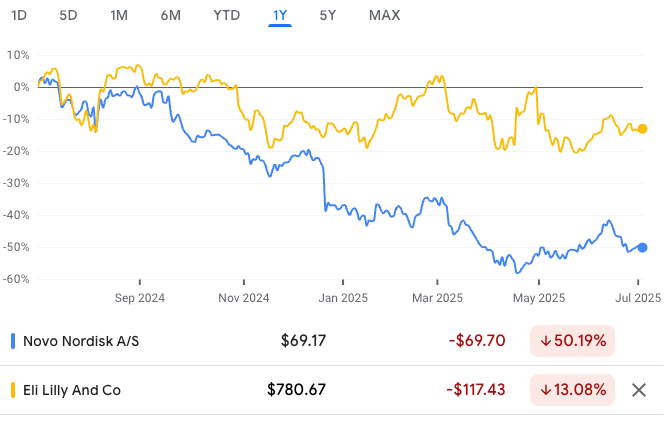Once the darling of the stock market, Novo Nordisk has seen its share price plunge by nearly 50% over the past year — and the thing is, it wasn’t even during a market crash. Most of the damage came from company-specific developments.
At one point, Novo Nordisk was the largest company in Europe by market cap. It has since dropped to third place. LVMH had its moment at the top too, but now it’s been overtaken by rival Hermès, falling to fifth. It just goes to show how hard it is to maintain sky-high valuations — and a reminder to investors that valuation matters. Hype fades. Share prices swing. And if you buy blindly at the top, it usually doesn’t end well.
Problems, Problems, and More Problems
Novo Nordisk’s rise was fueled by its miracle drug class — GLP-1s. Originally developed for diabetes (marketed as Ozempic), the same compound, semaglutide, was later approved for weight loss under the Wegovy brand. These drugs drove the bulk of Novo’s growth in recent years, with annual revenue increases above 20%. At its peak, Novo controlled more than half of the global GLP-1 market.
But the lead didn’t last. Arch-rival Eli Lilly launched its own GLP-1 treatments — Mounjaro for diabetes and Zepbound for obesity — and by Q1 2025, Lilly had overtaken Novo in U.S. market share, claiming around 53% of GLP-1 prescriptions.
That’s one of the likely reasons why Novo’s share price dropped so much more than Lilly’s — Novo down 50%, while Lilly only declined ~13%. But clearly, the GLP-1 hype has cooled.
Another major factor? Efficacy. Lilly’s Zepbound showed 22.5% average weight loss at 72 weeks, while Novo’s Wegovy came in at 14.9% at 68 weeks. That’s a significant difference.






